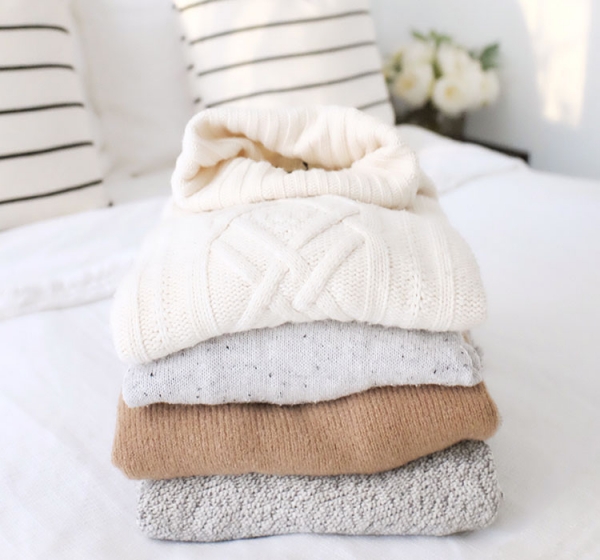
Source: Alaina Kaczmarski for The Everygirl
When the weather is cold, you know exactly what you want to reach for when getting dressed in the morning—not your silky camisole, not your trendy blazer, and not your fancy work top. No, when the weather is freezing, you want to reach for a trusted, comfy, so-cozy-you-never-want-to-take-it-off sweater. From early fall to the end of winter, a sweater is undoubtedly your best friend. And like any other best friend, sweaters require love and care. While they’re extremely delicate, they can last through many wears and many seasons if you treat them the right way. Here are eight sweater care tips to help you properly take care of all your knits so they can last as long as you want them to:
1. Remove pills the right way
Is there anything as annoying as pilling on a favorite sweater!? A perfectly fine and pretty wool cardigan can start to look like an ungroomed dog after a while. Unfortunately, all sweaters pill—it’s caused by rubbing during wear and is more apparent around the elbows, under armpits, and on sleeves, but it can occur anywhere on the sweater. To remove pills easily, hold the sweater flat with one hand and slice the pills off (one at a time) with a razor. You can also buy a pill remover. Do not pull at them or else the pilling will become worse.
2. Turn noticeable snags inside out
Snags (AKA when the stitch comes out of the sweater) are the worst because they seem unfixable, and you risk the sweater unraveling if the snag gets caught on something. Snags are not completely fixable, but luckily, they can be placed on the inside so that they’re no longer an issue on the outside. Simply turn the sweater inside out, insert a crochet hook into the same stitch as the snag, and carefully pull the snag through (a safety pin will also work in a pinch). You’ll no longer be able to see the snag, and you won’t run the risk of the snag getting caught on something.
View this post on Instagram
3. Regularly remove dandruff, hair, and lint
Thanks to the soft wool, knit, or cashmere that we all know and love, the fabric of sweaters can sometimes act as a magnet, attracting and sticking to dust, lint, dandruff, or strands of hair. A child’s soft hairbrush or a soft toothbrush will help you quickly brush off anything on the sweater (looking at you, dog hair!) for an easy fix, but make sure not to brush too harshly on the sweater or it will loosen the fabric and create pills. You can brush through after every wear, but a quick TLC for all your sweaters once a month is sufficient to prevent lint, dandruff, dust, or hair pile-up.
4. Know how to wash (and when)
PSA: Washing your sweaters doesn’t have to be a pain. Most sweaters should be hand washed so they last longer and the fabric stays intact. To hand wash, fill a bucket or sink with cool water, add a few squirts of gentle laundry detergent, submerge the sweater, and let it soak for about 30 minutes. Then, rinse it under cool water. To dry, gently squeeze water out the sweater (never wring it out) and roll it up in a towel (like a sleeping bag or sushi roll) to suck up all the excess water. Finally, lay it flat on a drying rack or clean towel to dry.
Cotton and cashmere typically need to be washed after two to three wears, while wool or polyester can withstand about five wears. But make sure to follow the directions on the label, and don’t wash more often unless the sweater has a stain (like sweat or a spill). And if it says dry clean only (as it does with most wool), then you know the drill: dry clean only.
5. To extend washes, wear a T-shirt underneath
Even gentle hand washing can wear down the quality, fabric, or softness of any sweater over time, so if you wear your sweaters frequently, consider wearing a T-shirt underneath to extend the time in between washes. Wearing a T-shirt acts as a barrier between the sweater and skin, limiting the amount of outside forces and smells the fabric interacts with. Since things like sweat, body odor, oils on the skin, and deodorant can cause wear and tear, the sweater stays intact longer when you wear a layer underneath that acts as a barrier. Now all you have to worry about is spilling your latte.
View this post on Instagram
6. You can save an itchy sweater
Is there anything worse than a sweater so itchy, it loses all its coziness? In order to turn itchy back to soft and cozy, add liquid fabric softener to the cold water when you’re hand-washing your sweater. Allow the sweater to thoroughly swirl around the water and let it sit. You can also try adding half a cup of hair conditioner instead of fabric softener for extra softness. Just make sure you avoid 2-in-1 conditioner/shampoo combinations or heavy hair masks and stick to hydrating or standard conditioner (not other formulas meant for volumizing or thickening). After one to three treatments, your sweater should be back to its soft and cozy self.
7. Store sweaters properly
Repeat after me: Never hang sweaters. Hanging will cause sweaters to stretch out and create peaks in the shoulders. To store them in a way that maintains their shape and quality, keep sweaters folded or rolled in drawers or on shelves. Properly fold them by laying them front-down on a flat surface and fold each arm (from the sleeve seam diagonally across the sweater’s back). Then, either fold it horizontally in half or roll from the bottom hem up to the collar. If you must hang them, fold the sweater over the hanger, on top of a piece of tissue paper to prevent creases.
8. Pack up sweaters after winter
Yes, all good things must come to an end, and when sweater season is over, your sweaters deserve to be stored the right way for extra protection and to help hold shape through the spring and summer months. Don’t just throw them in bins as is and hope for the best. Take the time to properly clean them, fold them, and put them in clothing storage bags (that are breathable) or boxes (as long as they’re made out of cotton or canvas). Add in a small satchel filled with lavender to prevent bugs (and keep them smelling fresh!). Hot tip: Do not put sweaters in vacuum-sealed storage bags. It might seem like it’s saving space, but locking in moisture can cause yellowing or mildew.

The Best Sweaters From H&M This Fall
READ NOW
